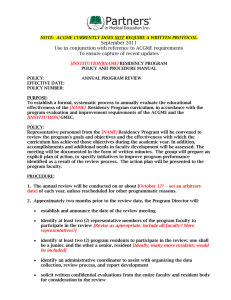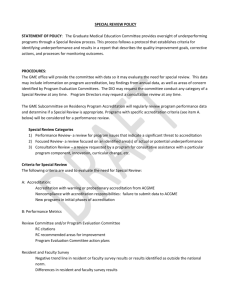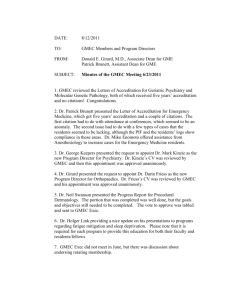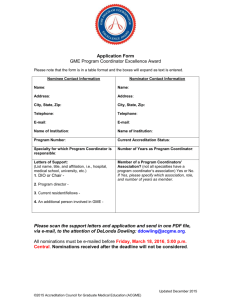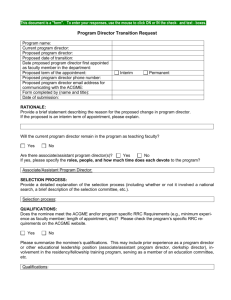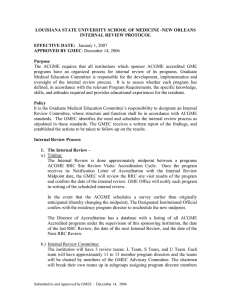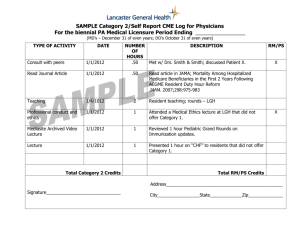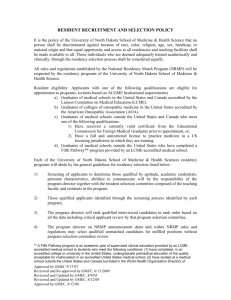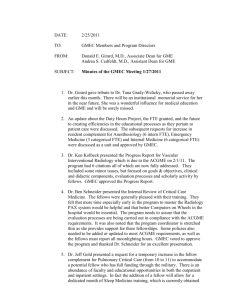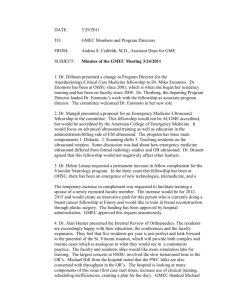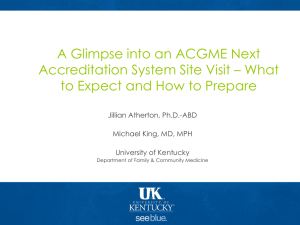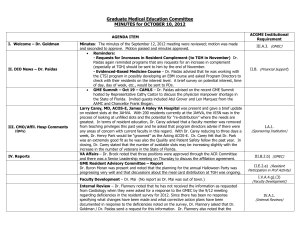ACGME Internal Review Requirement
advertisement
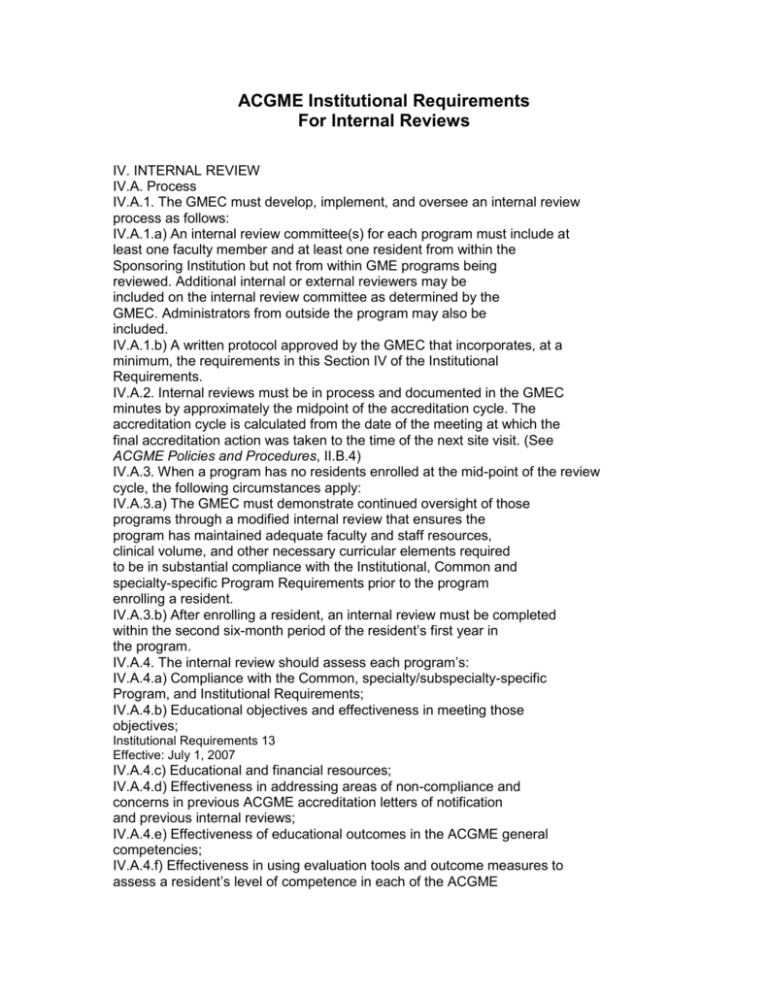
ACGME Institutional Requirements For Internal Reviews IV. INTERNAL REVIEW IV.A. Process IV.A.1. The GMEC must develop, implement, and oversee an internal review process as follows: IV.A.1.a) An internal review committee(s) for each program must include at least one faculty member and at least one resident from within the Sponsoring Institution but not from within GME programs being reviewed. Additional internal or external reviewers may be included on the internal review committee as determined by the GMEC. Administrators from outside the program may also be included. IV.A.1.b) A written protocol approved by the GMEC that incorporates, at a minimum, the requirements in this Section IV of the Institutional Requirements. IV.A.2. Internal reviews must be in process and documented in the GMEC minutes by approximately the midpoint of the accreditation cycle. The accreditation cycle is calculated from the date of the meeting at which the final accreditation action was taken to the time of the next site visit. (See ACGME Policies and Procedures, II.B.4) IV.A.3. When a program has no residents enrolled at the mid-point of the review cycle, the following circumstances apply: IV.A.3.a) The GMEC must demonstrate continued oversight of those programs through a modified internal review that ensures the program has maintained adequate faculty and staff resources, clinical volume, and other necessary curricular elements required to be in substantial compliance with the Institutional, Common and specialty-specific Program Requirements prior to the program enrolling a resident. IV.A.3.b) After enrolling a resident, an internal review must be completed within the second six-month period of the resident’s first year in the program. IV.A.4. The internal review should assess each program’s: IV.A.4.a) Compliance with the Common, specialty/subspecialty-specific Program, and Institutional Requirements; IV.A.4.b) Educational objectives and effectiveness in meeting those objectives; Institutional Requirements 13 Effective: July 1, 2007 IV.A.4.c) Educational and financial resources; IV.A.4.d) Effectiveness in addressing areas of non-compliance and concerns in previous ACGME accreditation letters of notification and previous internal reviews; IV.A.4.e) Effectiveness of educational outcomes in the ACGME general competencies; IV.A.4.f) Effectiveness in using evaluation tools and outcome measures to assess a resident’s level of competence in each of the ACGME general competencies; and, IV.A.4.g) Annual program improvement efforts in: IV.A.4.g).(1) resident performance using aggregated resident data; IV.A.4.g).(2) faculty development; IV.A.4.g).(3) graduate performance including performance of program graduates on the certification examination; and, IV.A.4.g).(4) program quality. (see Common Program Requirements, V.C.) IV.A.5. Materials and data to be used in the review process must include: IV.A.5.a) The ACGME Common, specialty/subspecialty-specific Program, and Institutional Requirements in effect at the time of the review; IV.A.5.b) Accreditation letters of notification from previous ACGME reviews and progress reports sent to the respective RRC; IV.A.5.c) Reports from previous internal reviews of the program; IV.A.5.d) Previous annual program evaluations; and, IV.A.5.e) Results from internal or external resident surveys, if available. IV.A.6. The internal review committee must conduct interviews with the program director, key faculty members, at least one peer-selected resident from each level of training in the program, and other individuals deemed appropriate by the committee. IV.B. Internal Review Report IV.B.1. The written report of the internal review for each program must contain, at a minimum: IV.B.1.a) The name of the program reviewed; Institutional Requirements 14 Effective: July 1, 2007 IV.B.1.b) The date of the assigned midpoint and the status of the GMEC’s oversight of the internal review at that midpoint; IV.B.1.c) The names and titles of the internal review committee members; IV.B.1.d) A brief description of how the internal review process was conducted, including the list of the groups/individuals interviewed and the documents reviewed; IV.B.1.e) Sufficient documentation to demonstrate that a comprehensive review followed the GMEC’s internal review protocol; IV.B.1.f) A list of the citations and areas of non-compliance or any concerns or comments from the previous ACGME accreditation letter of notification with a summary of how the program and/or institution subsequently addressed each item. IV.B.2. The DIO and the GMEC must monitor the response by the program to actions recommended by the GMEC in the internal review process. IV.B.3. The Sponsoring Institution must submit the most recent internal review report for each training program as a part of the Institutional Review Document (IRD). If the institutional site visitor simultaneously conducts individual program reviews at the same time as the institutional review, the internal review reports for those programs must not be shared with the site visitor. ACGME Approved: February 2007 Effective: July 1, 2007 ACGME Approved Minor Revision: June 14, 2009 Effective: July 1, 2009 Footnote for I.A.2 * Further use in this document of the term “program(s)” will refer to “ACGME-accredited program(s).” Footnote for II.A.1.d ** A Fifth Pathway program is an academic year of supervised clinical education provided by an LCMEaccredited medical school to students who meet the following conditions: (1) have completed, in an accredited college or university in the United States, undergraduate premedical education of the quality acceptable for matriculation in an accredited United States medical school; (2) have studied at a medical school outside the United States and Canada but listed in the World Health Organization Directory of Medical Schools; (3) have completed all of the formal requirements of the foreign medical school except internship and/or social service; (4) have attained a score satisfactory to the sponsoring medical school on a screening examination; and (5) have passed either the Foreign Medical Graduate Examination in the Medical Sciences, Parts I and II of the examination of the National Board of Medical Examiners, or Steps 1 and 2 of the United States Medical Licensing Examination (USMLE).
